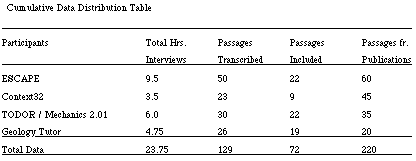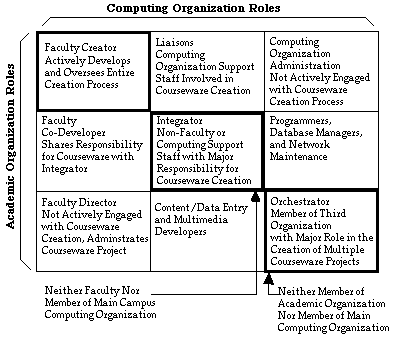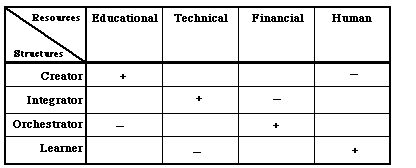
Interviews with 19 key participants and information from publications were used to document organizational practices within successful courseware projects in distributed computing environments. Participants across projects emphasized the importance of obtaining the resources required for maintaining projects on an ongoing basis. The inclusion of learner construction within traditional course support structures provided the necessary combination of resources which contributed to the success of projects.
[An expanded version of this document can be found in the following document upon which this article was based: Courseware Projects in Advanced Educational Computing Environments (CPIAECE): Chapter 5 Organizational Contexts.]
Introduction
During the 1980s and early 1990's, academic computing organizations like Brown's Intermedia and MIT's Athena invested in distributed computing systems which were the prototypes for those that are rapidly becoming generally available to education recently (Champine, 1991; Landow, 1989). Their investment in "studying tomorrow today" has presented a unique opportunity to study a "sample of today" with unusual hindsight. The long term probability of success for the new distributed educational computing projects like those on the World Wide Web (WWW) may be improved by learning from projects which experimented with distributed electronic educational computing systems in the past.
Methodology
Interviews with 19 key participants and information from major publications were used to document the educational, technical, financial, and personnel policies within the organization(s) which supported successful courseware projects.
|
The following projects, organizations and participants were the focus of this study:
Project: ESCAPE (HyperCard and HyperNews) Organizations: Educational Research and Information Systems (ERIS, Purdue) Participants: Hopper, Lawler, LeBold, Putnam, Rehwinkel, Tillotson, Ward Project: TODOR (BLOX) & Mechanics 2.01 (cT, Athena) Organizations: Athena and Academic Computing (AC, MIT) Participants: Bucciarelli, Daly, Jackson, Lavin, Schmidt Project: Physical Geology Tutor (AthenaMuse) Organizations: Center for Educational Computing Initiatives (CECI, MIT) Participants: Davis, Kinnicutt, Lerman, Schlusselberg Project: Context32 (Intermedia, StorySpace) Organizations: Institute for Research and Information Scholarship (IRIS, Brown) Participants: Kahn, Landow, Yankelovich [See the Switchboard for further information.] |
The cumulative data distribution in Table 1 reflects both the number of passages from interviews that were transcribed, and the number that were approved for inclusion in the database and public documents (see Table 1).

Table 1: Cumulative Data Distribution Table
This table appears to show that publications were the primary source of data for this study. This misleading impression is the result of a strategy used to avoid imposing on participants for a time consuming review process required before passages from interviews could be made available for publication. When key points were emphasized by participants during interviews that were also available in published form, documentation was drawn from the previously published sources. Data collection thus included searching for published passages to illustrate specific points highlighted during interviews. While the passages finally used in the report came from previously published reports, the relative emphasis on them was determined through experiences and insights gained from personal interviews.
Results
This study found that there were unique organizational or "human" factors in these projects which were critical to their success and continuation. The most intriguing finding was that the implicit or explicit inclusion of learners in constructing their own electronic learning environments contributed to the success of projects in ways that went beyond the purely pedagogical explanations traditionally emphasized in educational computing project reports. The choice of including learners in the construction of their own educational materials addressed the most pragmatic project management dilemmas and unique organizational challenges that arose in projects founded in distributed computing environments.
Courseware's existence in these environments depended upon continuous delivery and modification. The discontinuation of either process generally marked the end of a project because courseware quickly fell from disuse to "unusability."
"The computational model of networked workstations with its tendency to change has far different implications than a personal computer where the operating system can be frozen forever." (Stewart, 1989, p. 302)
To insure that courseware was used, updated and expanded enough so that it existed over a significant period of time, authors of successful courseware needed to continually find ways to acquire critical resources. The most consistent themes during the projects in this study were the limitations and opportunities associated with the availability and scarcity of resources required for producing educational computing projects in distributed academic computing settings. Within all of the projects in the study, four different types of resources were consistently emphasized. These resources corresponded to the obvious key elements of educational computing projects:
Different organizational structures evolved to provide resources to continue courseware projects. The dilemma was to find ways both inside and outside of traditional structures to overcome the inherent lack of existing support structures for courseware development in academic settings. There were three structures of courseware teams that were identified. An overview of the types of organizational structures and the relationships among them are shown Figure 1 below (see Figure 1).

Figure 1: Organizational Structures
Tasks that originated from the academic nature of the projects were performed by people closely associated with academic organizations. Tasks that originated from the technical nature of projects were done by people who had relationships with the computing organization. When a faculty member took the majority of the responsibility for the creation of courseware, he or she was classified as an author or "creator". When a person took responsibility for courseware production who was neither faculty or a member of the computing organization, the role was described as an "integrator". Finally, sometimes independent organizations emerged which were neither traditional academic departments nor campus computing organizations. When a person from such an organization took responsibility for more than one courseware creation, they were referred to as "orchestrator". This structure often emerged when the organization was also engaged in the creation of the software tools as well as courseware support.
Figure 2 below illustrates the relative strengths and weaknesses of each of the above models relative to the types of resources required to maintain projects (see Figure 2). The most successful organizational structures were those that cast learners as authors, while courseware "authors" were recast as managers of the educational, technical and organizational factors which needed to be continuously balanced. The inclusion of learners provided the necessary stable source and combination of resources required to successfully produce the projects. This was particularly true because the same motivation and work patterns that were a problem for faculty or staff became a strength when viewed in the context of learner's construction of their own learning experience.

Figure 2: Comparison of Organizational Structures Relative to Resources
When courseware in these advanced distributed computing environments were constructed by students in the context of a course, or outside the context of the course and within the bounds of the team, it was both beneficial for the students and essential for the project. The activities that learners performed and their relationship to the organizations involved tended to vary according to the type of software function emphasized. When microworlds were constructed, students tended to serve in roles of programming. These tasks tended to bring them in fairly close association with the computing organization that supported the courseware project. On the other hand, when courseware emphasized databases of linked text, graphics, or multimedia, learners tended to fill the role of developers and were more closely associated with the academic organization which supported the courseware project.
Conclusion
The continuation and expansion of courseware beyond its initial funding depended upon a structure evolving to obtain resources, while overcoming the limitations inherent in the organizational structures surrounding the project. This caused a reinterpretation of courseware authoring as a process of establishing an ongoing system for obtaining and managing informational, technical, human and financial resources. The most sucessful projects included provisions which changed the roles of learner and author relative to the organizational structures. Learners became authors, while the roles of the key members of courseware teams changed from authors to learning environment managers. In the future, it will be valuable to consider the mutually beneficial roles which learners can play in building their own learning environments.